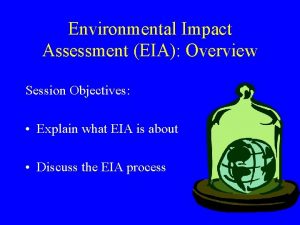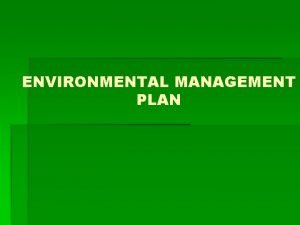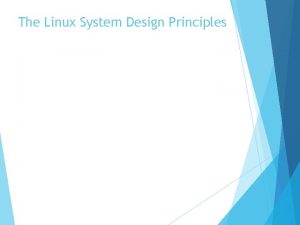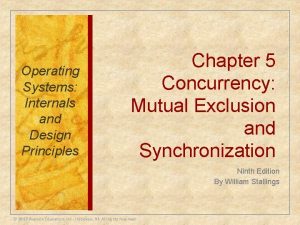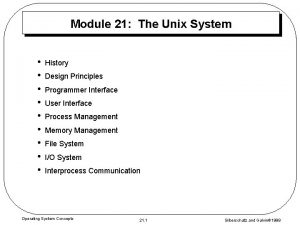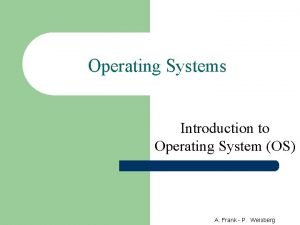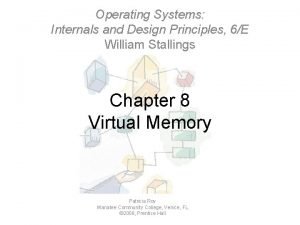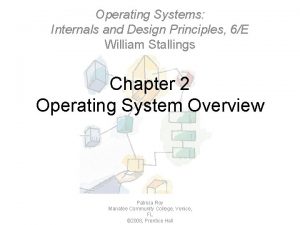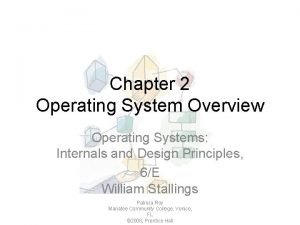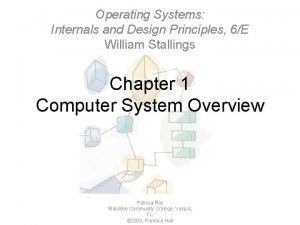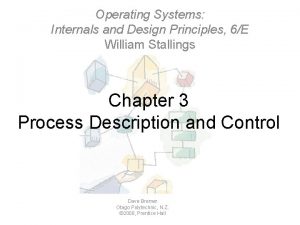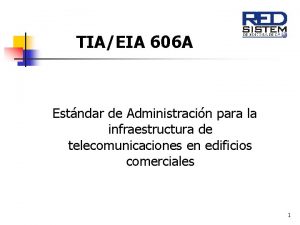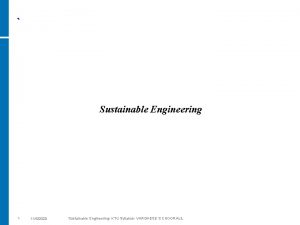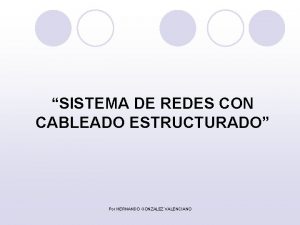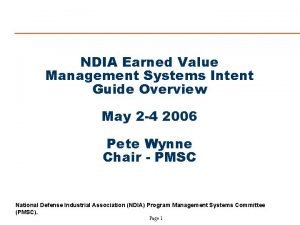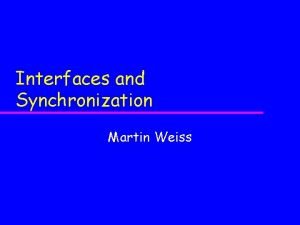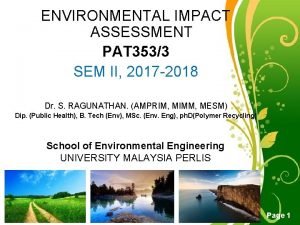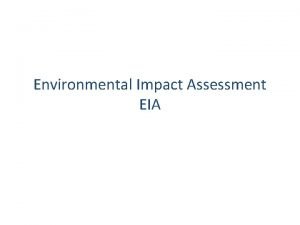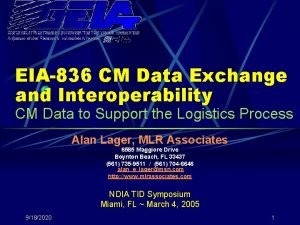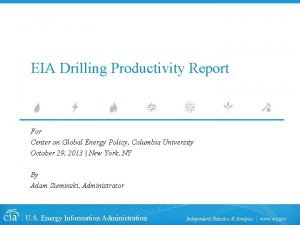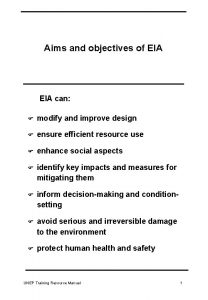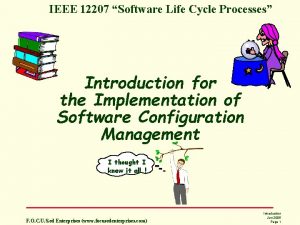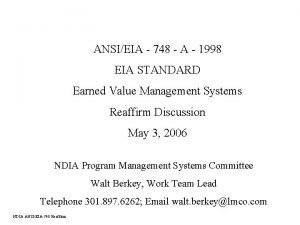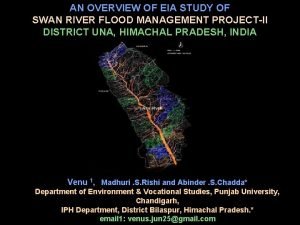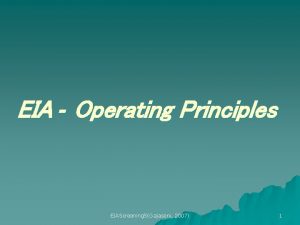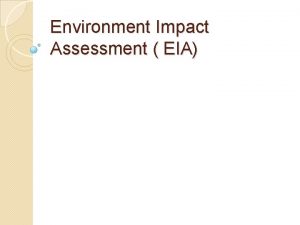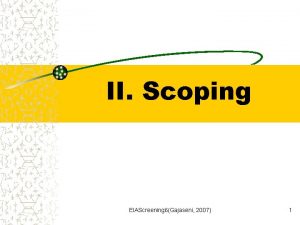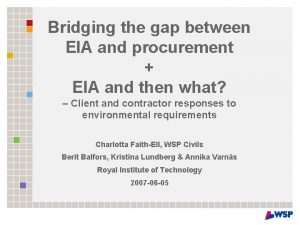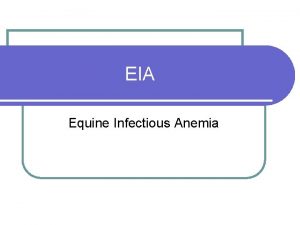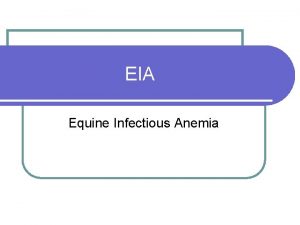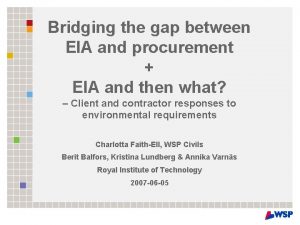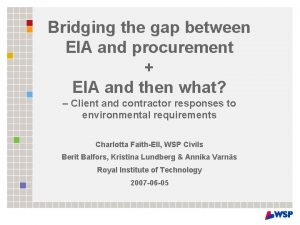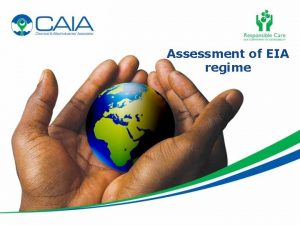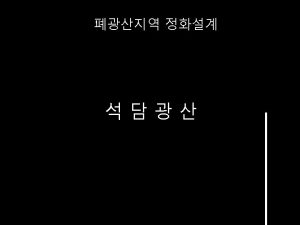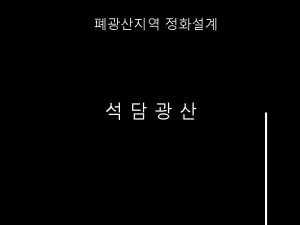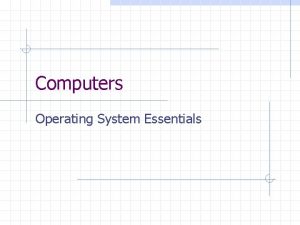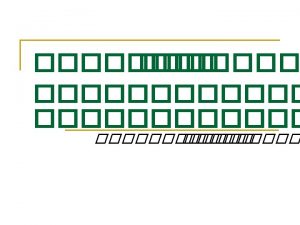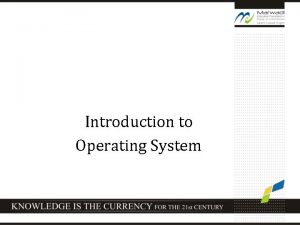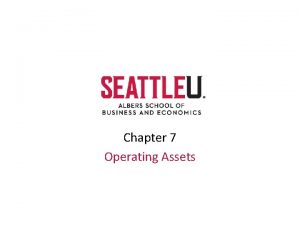EIA Operating Principles EIAScreening 5Gajaseni 2007 1 EIA



























- Slides: 27

EIA - Operating Principles EIAScreening 5(Gajaseni, 2007) 1

EIA - Operating Principles*** Screening u Scoping u Assessing u Mitigation u Reporting u Reviewing u Decision-making u Monitoring and management u Public involvement u EIAScreening 5(Gajaseni, 2007) 2

The EIA process: screening - to decide if and at what level EIA should be applied F scoping - to identify the important issues and prepare terms of reference F impact analysis - to predict the effects of a proposal and evaluate their significance F mitigation - to establish measures to prevent, reduce or compensate for impacts F EIAScreening 5(Gajaseni, 2007) 3

reporting - to prepare the information necessary for decision-making F review - to check the quality of the EIA report. F decision-making - to approve (or reject) the proposal and set conditions F follow up – to monitor, manage and audit the impacts of project implementation F public involvement - to inform and consult with stakeholders F EIAScreening 5(Gajaseni, 2007) 4

UNEP Training Resource Manual EIAScreening 5(Gajaseni, 2007) Topic 1 Slide 5 5

Public involvement Project Screening - is an EIA needed? Scoping – which impacts & issue to consider? Description of the proposed action Identification of key impacts Assessing: Prediction of impacts Evaluation & assessment of significant of impacts Identification of mitigation measures Presentation of finding in an EIA report (EIS) (including a non-technical summary) Review of the EIA report (EIS) Decision-making Post-decision monitoring Auditing of predictions and mitigation of measures EIAScreening 5(Gajaseni, 2007) Important Steps in the EIA Process 6

EIA process I. Screening EIAScreening 5(Gajaseni, 2007) 7

SCREENING u Definition: – is the process of determining whether or not a proposal requires full-scale EIA and the level at which that assessment should occur. EIAScreening 5(Gajaseni, 2007) 8

The purpose of screening is to determine: Fwhether or not a proposal requires an EIA Fwhat level of EIA is required EIAScreening 5(Gajaseni, 2007) 9

Outcomes of screening F full or comprehensive EIA required F more limited EIA required F further study needed to determine EIA requirement F no further requirement for EIAScreening 5(Gajaseni, 2007) 10

Screening and scoping compared Screening Fdetermines the requirement for EIA Festablishes the level of review necessary Scoping Fidentifies the key issues and impacts Festablishes the terms of reference EIAScreening 5(Gajaseni, 2007) 11

Requirement of full-scale EIA involves: u exploitation of natural resources u infrastructure u industrial activities u extractive industries u waste management and disposal u substantial changes in farming or fishing practices EIAScreening 5(Gajaseni, 2007) 12

Screening methods F legal/policy definition F inclusion list of projects (with or without thresholds) F exclusion F criteria list of projects for case-by-case screening EIAScreening 5(Gajaseni, 2007) 13

Approaches to screening involve one or a combination of: u decision-makers’ discretion u initial environmental examination u project lists with/without thresholds u exclusion lists EIAScreening 5(Gajaseni, 2007) 14

EIAScreening 5(Gajaseni, 2007) 15

Decision-maker’s discretion: the proposal itself and its potential impacts u the level of confidence in the predicted impacts u the characteristics of the receiving environment and its resilience to change u the existing planning, environmental management and decision-making framework u the degree of public interest likely in the proposal u EIAScreening 5(Gajaseni, 2007) 16

Initial environmental examination (evaluation) u u u describe the proposal and examine any alternatives that might improve the environmental outcomes identify and address the concerns of the local community identify and assess the potential environmental effects mitigate adverse effects and enhance potential benefits contain environmental monitoring and management plans EIAScreening 5(Gajaseni, 2007) 17

Project lists: establish a set of specific criteria that can be used to determine which projects will undergo EIA. u requiring full-scale EIA u requiring some form of further environmental analysis u not requiring any further environmental analysis EIAScreening 5(Gajaseni, 2007) 18

Exclusion lists: u The use of exclusion lists is not a common approach to screening. u The use is that the greater number of smaller and less significant projects are given exemption from EIA based on project type or size. EIAScreening 5(Gajaseni, 2007) 19

Thailand: Type and sizes of projects or activities requiring EIA report. u 1. Industry u 2. Residential building and service community u 3. Transportation u 4. Energy u 5. Water resource u 6. Watershed area u 7. Mine EIAScreening 5(Gajaseni, 2007) 20

EIAScreening 5(Gajaseni, 2007) 21

Lists of actions: u Utilising of positive/inclusive nature u Utilising of negative/exclusive nature u Weakness of lists based on types of action without considering to – size – technology – resource requirements – waste characteristics EIAScreening 5(Gajaseni, 2007) 22

Three possible outcomes of screening process: u 1. proposals which do not require additional environmental investigation because it is expected that they will not have significant impacts u 2. proposals which require a limited environmental study because the environmental impacts are known and can be easily mitigated EIAScreening 5(Gajaseni, 2007) 23

u 3. proposals which require EIA to determine the extent and magnitude of range of significant adverse impacts and to propose a range of appropriate mitigation, monitoring and management measures EIAScreening 5(Gajaseni, 2007) 24

Ex: Egypt u 3 lists of project criteria; –. 1 White list u. No EIA requirement –. 2 Gray list u. Scoped EIA study may be required. –. 3 Black list u. Full EIA study is required. EIAScreening 5(Gajaseni, 2007) 25

EIAScreening 5(Gajaseni, 2007) 26

A framework for screening Mandatory EIA Increasing impact of development ‘Inclusive’ threshold Case by case consideration of requirement for EIA ruled out EIA more likely to be required; screen borderline proposals for significant environmental effects ‘Indicative’ threshold EIA less likely to be required but still screen for significance where the location is sensitive or if there is a potential for cumu Exclusive threshold UNEP Training Resource Manual Topic 4 EIAScreening 5(Gajaseni, 2007) Slide 27 27
 Evolution of eia
Evolution of eia Basic principles of eia
Basic principles of eia Design principles of linux system
Design principles of linux system Operating system internals and design principles
Operating system internals and design principles Unix design principles
Unix design principles Operating systems: internals and design principles
Operating systems: internals and design principles Slidetodoc.com
Slidetodoc.com Operating systems: internals and design principles
Operating systems: internals and design principles Operating systems: internals and design principles
Operating systems: internals and design principles Operating systems: internals and design principles
Operating systems: internals and design principles Operating systems internals and design principles
Operating systems internals and design principles Operating system internals and design principles
Operating system internals and design principles Eia 606
Eia 606 Environmental impact assessment ktu syllabus
Environmental impact assessment ktu syllabus Ansi/tia/eia-606-a
Ansi/tia/eia-606-a Ndia evms
Ndia evms Eia-232-d
Eia-232-d Eia process
Eia process Methods of eia
Methods of eia Environmental auditing
Environmental auditing Eia-836
Eia-836 Drilling productivity report
Drilling productivity report Eia is 632
Eia is 632 Characteristics of a good eia
Characteristics of a good eia Eia objectives
Eia objectives Primary life cycle processes
Primary life cycle processes Ansi/eia 748
Ansi/eia 748 Eia swan river
Eia swan river
